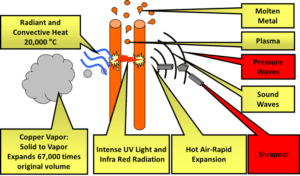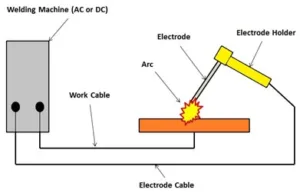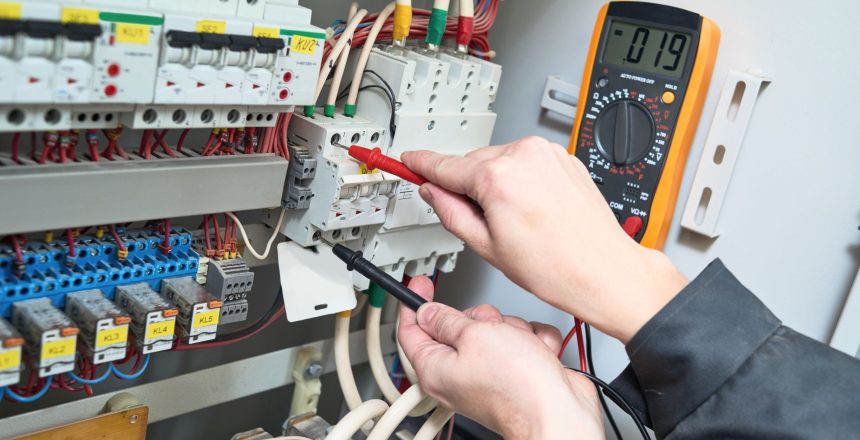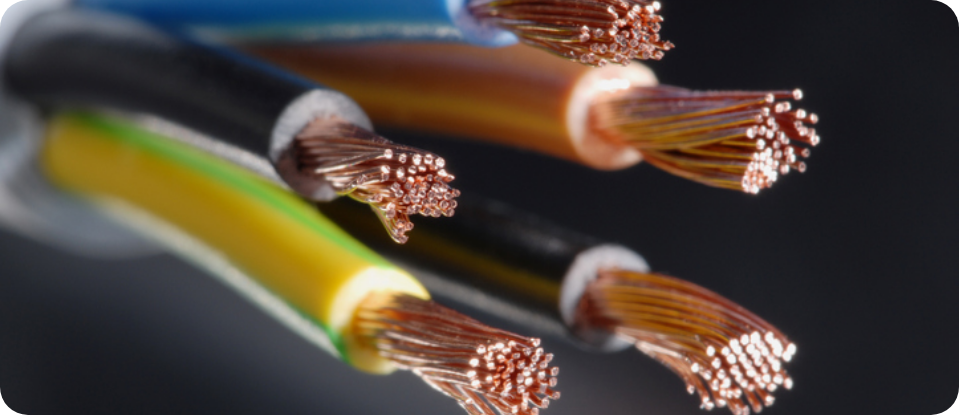Principal Consultant, Paul Hopton, explores potential Arc Flash hazards and control measures to be used to reduce the risk of injury.
Arc Flash Hazards

Let’s take a look at the hazards you could be exposed to during an arc flash event. As you can see from the diagram below there are a lot of hazards, but the primary hazard is heat. People injured by arc flash, suffer burn injuries. Very much the secondary hazard is “arc blast”, which is an explosive burst of energy that occurs during an arc flash. Arc flash PPE is primarily aimed at protecting personnel from the heat hazard.
Arc Flash Initiating Events
Arc flash is a type of electrical explosion or discharge that results from a connection through air to earth or another voltage phase in an electrical system.
Consider first arc welding, the diagram below shows a basic arrangement:

The arc at the electrode tip is initiated by “striking” the tip on the item to be welded. The process of initiating an arc during an arc flash event is very similar, there has to be an initiating event for the arc to be produced.
An arc flash event can be initiated in a number of ways, some examples are:
- Operation of switchgear.
- Insulation failure.
- Opening/closing of access panels (hinged and fixed)
- Testing and Fault Finding.
- Working in proximity to live conductive parts/live working.
- Isolation errors e.g. mislabelling of equipment, unfamiliarity with site/equipment, incorrect documentation.
- Errors related to competency.
- And the list goes on…………….
Arc Flash Control Measures
The best and most often used control measure to protect personnel from arc flash is to isolate the equipment before you work on it.
No electricity = No arc flash
However, we cannot always remove the power when operating or working on electrical equipment. So, what other control measures are available to us? Well, as with most electrical safety management problems, a multi-faceted approach is recommended. Let’s start with the most unreliable part of any electrical system – the human.
Training & Competence
The operators of electrical equipment (switchgear, MCC’s, etc.) should be trained in the safe operation of the electrical equipment that they operate. This training should include an understanding of arc flash risk and the results of any arc flash risk analysis that has been completed. Persons that work on or near energised conductors that pose an arc flash risk should be trained to understand the hazards associated with arc flash, as well as the arc flash boundaries, the use of arc flash warning labels, and the selection and use of personal protective equipment. Training should always be conducted by competent persons with appropriate experience and a thorough understanding of arc flash safety practices.
Electrical first aid
Personnel working with electricity can be exposed to electric shock and electric arc flash risk. The locations where electrical personnel work are sometimes remote or secure (e.g. locked Electricity substations and switch rooms). Electrical personnel should be trained and competent in the first aid actions required to safely deal with electric shock and arc incidents.
The training should typically include:
- Cardio-Pulmonary Resuscitation (CPR)
- The recovery position
- Electric shock treatments and the use of burns kits
- The safe use of electrical safety hooks
Access to electrical areas
Areas where arc flash risk could be expected to occur should have access restricted. Access to these areas should be minimised and wherever possible electrical switch rooms should be locked, with access restricted to electrically authorised persons that have the knowledge and experience to be able to recognise the potential hazards.
Now let’s take a look at how we might be able to reduce or eliminate the hazard by engineering out the problem.
Engineering Controls
We can often reduce the arc flash incident energy on any given piece of equipment by:
- Reducing the fuse size – be careful as you cannot assume that reducing the fuse size will reduce incident energy. You will need to calculate the incident energy before and after the proposed change to make sure the incident energy is lower after the change.
- Adjusting circuit breaker and/or protection relay settings – again be careful as you will have to make sure that protection co-ordination is maintained. Where circuit breakers have instantaneous settings, lowering this setting is often very effective in reducing the incident energy.
Potential incident energy should be minimised as far is reasonably practicable by minimising available arc flash fault current and/or fast clearing of a fault before it develops into a hazardous arc flash condition. Faults can be reduced in a number of ways but consider the following:
- Use of current limiting fuses/breakers e.g. fast acting circuit breakers or fuses.
- System configuration can be used to reduce available fault current e.g. smaller kVA transformers.
- Current limiting reactors.
High Intensity Light Monitoring (Arc Flash Relays)
The intensity of light instantaneously released by an arcing fault can be thousands of times higher than normal ambient light, and it is this phenomenon that is used in arc flash detection relays to achieve faster operating times than is possible with conventional relays. Optical sensors detect the sudden increase in light intensity. Instantaneous over-current elements are used as fault detectors to supervise the optical system for security.
In high intensity light monitoring systems one of the aims is to minimise the arc flash detection time (typically as low as a few milliseconds). This aim can be met by detecting the light from an arc flash and initiating tripping action via solid-state tripping elements. Refer to IEC 62271-200:2021 High-voltage switchgear and control gear for more information.
Switchgear Protection
Switchgear can be designed and tested to mechanically withstand an arc flash event. Protection is afforded by the containment of the arc within the switchgear. Whilst this will not protect personnel working on the equipment with doors open or covers removed, it can go a long way to protect personnel operating the switchgear. It should be noted however, that to maintain this protection, modifications over time or missing/incorrectly tightened fasteners can result in degraded protection.
Ultra-Fast Earthing Switch UFES
Arc quenching systems that provide high levels of protection for LV and HV systems against the hazardous impacts of internal arc faults. In case of an internal arc fault, an arc detection relay trips the UFES, which earths all three phases to extinguish the arc.
Remote Operation, Racking/Switching Devices and Robots
Remote operation of switchgear is relatively easy to implement with new and existing equipment, a fixed switching panel can be installed in a safe area. Many switchgear manufacturers offer devices that can be used to switch and/or rack in and out switchgear remotely. This remote operation capability ensures that personnel can be outside the arc flash boundary distance when operating switchgear.
Electrical Protection Schemes
There are a number of ways the protection system can be designed to help control arc flash hazard; some examples are given below:
- Enable Instantaneous Protection during Maintenance to lower the potential incident energy if an arc flash occurs.
- Bus Differential Protection Systems.
- Reduce the co-ordination time intervals of overcurrent relays.
- Zone interlocking using overcurrent relays.
Next, let’s take a look at risk assessment. At Electrical Safety UK we recommend to our clients that where, after some reasonable effort, we are unable to reduce the incident energy level below 8 cal/cm2 on a given piece of equipment, we should carry out a task-based risk assessment on that equipment. We will now look at that process.
Arc Flash Task Based Risk Assessment
Credible scenarios should be considered that can result in personnel being exposed to arc flash events. The scenarios should consider the risk to personnel from arc flash. Personnel should be advised and informed about:
- The use of PPE should be the last line of defence.
- the fundamentals of arc flash.
- the results of specific arc flash risk assessments for their work locations.
- the likely activities that can result in them being exposed to arc flash.
- the actions they can take to ensure that their exposure to arc flash risk is acceptable.
- the behaviour expected of them by their company to prevent harm occurring to themselves and others.
- the correct use and availability of PPE – PPE rating should be verified by testing.
- labelling of electrical equipment for arc flash risk.
Generic and specific tasks
When considering the risk of personnel being harmed by arc flash, consideration needs to be given to the tasks that are likely to be carried out on the equipment being assessed. Typical activities could include:
- Local closing/opening of a circuit breaker – consider increased likelihood of failure after maintenance/overhaul.
- Removal of fuses in switchboards, fuse boards and motor control centres.
- Local switching.
- Access to switch rooms with energised equipment.
- Racking of circuit breakers in/out of service.
- Proving dead.
- Opening/closing of hinged doors.
- Removal/refitting of covers.
- Using phasing sticks.
- Secondary injection tests of relays on switchboards.
- Working on or in proximity to live conductive parts.
- Using tools or test equipment.
- Carrying out thermography.
- Any other activity that is carried out on the equipment that could expose you to an arc that is not listed above.
For each activity, you should consider the likelihood of being exposed to an arc as well as the level of incident energy you could be exposed to if an arc did occur. The results of the risk assessment should be available to all electrical personnel and contractors. It is also a good idea to place a hard copy of the risk assessment on the equipment, so personnel can review its contents before starting work on the equipment.
Switching and Switching Programs
Careful consideration should be given to the operation of switchgear and in what sequence switchgear is operated when carrying out a switching program. One example is the isolation of an LV switchboard for maintenance. The incoming LV circuit breaker to the switchboard is likely have a higher incident energy level at its incoming terminals than the HV circuit breaker upstream of the transformer. If this is the case, operation of the HV switchgear before the LV switchgear would make sense, as the LV incomer would be de-energised during the switching operation.
Labelling
An arc flash study should be carried out to determine the worst-case incident energy level that personnel could be exposed to, on each piece of equipment on the network. As part of the study, warning labels should be applied to each piece of equipment. The labels should include the following information:
- Nominal system voltage – voltage between phases.
- Magnitude of incident energy – this should be given for the working distance from a prospective arc.
- Arc flash boundary – the distance away from a prospective arc at which the incident energy could result in a second-degree burn (< 1.2 cal/cm2)
- Working distance – specified by the Standard used to carry out the arc flash incident energy calculations.
- Arc Flash PPE requirements – this should be aligned to your arc flash PPE policy.
- Equipment Name/Identifier – Tag number, Network reference number etc.
Personal Protective Equipment (PPE)
The final control measure is arc flash PPE. To learn more about arc flash PPE specification please see my article at https://elecsafety.co.uk/arc-flash-personal-protective-equipment-ratings-explained/.
Contact us to find out more
More news & views
Electrical Safety news

Standards for Electrical Test Instruments and Test Leads
Test instruments and test leads are a temporary connection to electrical systems, often live at the time, for the purpose of making measurements.
Electrical Safety news

BS 7671 2022 Updates – Changes To The Wiring Regulations
The second amendment to the 18th Edition IET Wiring Regulations are out, and all of the IET Guidance Notes have been updated accordingly. Electricians and engineers have had time to digest every minute detail and discuss the implications at length.
Electrical Safety news

Electrical Safety Management System – Electrical Safety Policy
One question we are often asked is, what should an ESMS contain? has prompted me to write a series of articles looking at the different aspects of this vital policy document ESMS. Here is the first article in that series


